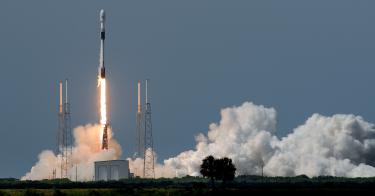On June 30, just a few minutes shy of 4 p.m., the U.S. Space Force launched its third Global Positioning Satellite Block III (GPS III) satellite into orbit. The launch went unnoticed by the vast majority of Americans, but it was another unmistakable sign that, after years of decline, the United States is on a path to retake the lead in all aspects of space operations.
From Dwight Eisenhower through Barack Obama, every U.S. president sustained a policy—either actively or passively—of “space for peaceful purposes.” Several dabbled in anti-satellite (i.e., “satellite killer”) programs, but each ultimately decided to defund those efforts and limit the Defense Department space missions to communications, reconnaissance and navigation.
Eisenhower’s decision to establish a “peaceful purposes only” policy was driven by altruistic motives. But not all countries embraced those motives or that policy. Over time, maintaining that policy required administrations to ignore a growing threat.
China conducted a successful anti-satellite test in 2007 and continued to refine its program in the early 2010s.
Meanwhile, the Obama administration didn’t just limit the military to a peaceful approach to space, it curtailed U.S. funding to benevolent space exploration programs. Mr. Obama oversaw the end of the Space Shuttle program, cancelled the follow-on “Constellation” crewed space program, and reduced overall U.S. strategic interest in space to the point where, in 2012, China executed half again more launches than the 12 the U.S. put into space.
During its last four years, the Obama administration watched as China and Russia furthered their ground-based missile and orbital anti-satellite capabilities, while avoiding the mere thought of space as a warfighting domain.
That began to change with the inauguration of President Trump and the 2017 the National Defense Authorization Act (NDAA). Over the next two years, Mr. Trump would establish Space Command as the 11th combatant command and support Congress’s move to establish the Space Force as the Pentagon’s fifth uniformed service.
The effort that brought Space Command and Space Force to life six months ago effectively ends the policy Eisenhower established 60 years ago. There is little question that the U.S. will always pursue peace, but the shackles associated with space for peaceful purposes will no longer keep the Defense Department from thinking, planning, and creating the infrastructure required to dominate this warfighting domain.
The June 30 launch is another marker to that end. Its GPS III satellite payload possesses robust anti-jamming capabilities and can operate in concert with other Global Navigation Satellite Systems, such as the European Galileo network and the Japanese Quasi-Zenith Satellite System. This gives the entire network an impressive level of resiliency, should any component come under attack.
Also notable is that the satellite was placed in orbit by SpaceX’s Falcon 9 reusable rocket delivery system. Eight years ago, only three private companies in the United States were involved in launching unmanned systems. Today, there are six.
SpaceX alone is scheduled to handle 31 launches this year—more than double the total U.S. tally for all of 2012. Private U.S. companies are scheduled to launch all 53 U.S. missions into space this year—10 more than China and Russia combined.
The classified nature of the majority of systems Space Force is placing in orbit makes any analysis of their offensive or defensive capabilities purely speculative.
While there are currently no known U.S. anti-satellite programs of record, the Space Force was established to regain the upper hand in this warfighting domain. With that, you can bet this new service is at work not just building systems that will counter the moves of others, but developing new space-borne and terrestrial-based assets to dominate other nations who chose to threaten the U.S. in this domain.
This piece originally appeared in The Washington Times



